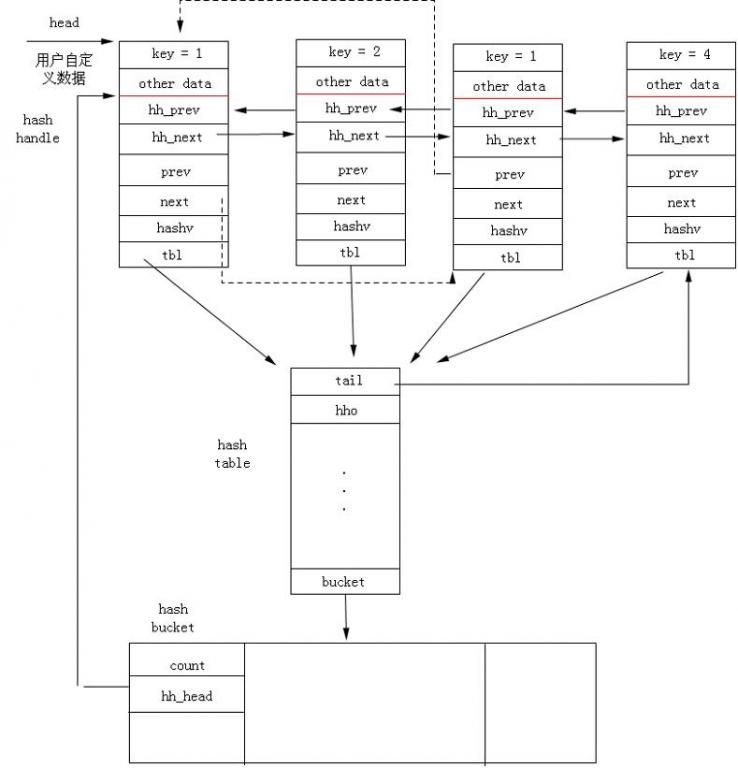开源hash代码uthash的原理与用法
来源:互联网 发布:淘宝网马云有多少股份 编辑:程序博客网 时间:2024/05/29 17:34
本文从以下两篇文章参考整理而来:
http://houjixin.blog.163.com/blog/static/356284102013101310454673/
http://blog.csdn.net/devilcash/article/details/7230733
uthash 是C的比较优秀的开源代码,它实现了常见的hash操作函数,例如查找、插入、删除等待。该套开源代码采用宏的方式实现hash函数的相关功能,支持C语言的任意数据结构最为key值,甚至可以采用多个值作为key,无论是自定义的struct还是基本数据类型,需要注意的是不同类型的key其操作接口方式略有不通。
使用uthash代码时只需要包含头文件"uthash.h"即可。由于该代码采用宏的方式实现,所有的实现代码都在uthash.h文件中,因此只需要在自己的代码中包含该头文件即可。可以通过下面两种方式获取源代码:
通过官方下载链接:
https://github.com/troydhanson/uthash
国外网络无法访问的时候,可以从下面网址获取:
http://download.csdn.net/detail/hjx_1000/6539789
另外,uthash的英文使用文档介绍可从下面网址获得:
http://troydhanson.github.io/uthash/userguide.html#_add_item
0.数据结构
uthash是用宏实现的,使用的时候非常方便,只用包含uthash.h即可。
Uthash的三个数据结构:
typedef struct UT_hash_bucket {
struct UT_hash_handle *hh_head;
unsigned count;
unsigned expand_mult;
} UT_hash_bucket;
UT_hash_bucket作用提供根据hash进行索引。
typedef struct UT_hash_table {
UT_hash_bucket *buckets;
unsigned num_buckets, log2_num_buckets;
unsigned num_items;
struct UT_hash_handle *tail; /* tail hh in app order, for fast append */
ptrdiff_t hho; /* hash handle offset (byte pos of hash handle in element */
unsigned ideal_chain_maxlen;
unsigned nonideal_items;
unsigned ineff_expands, noexpand;
uint32_t signature; /* used only to find hash tables in external analysis */
#ifdef HASH_BLOOM
uint32_t bloom_sig; /* used only to test bloom exists in external analysis */
uint8_t *bloom_bv;
char bloom_nbits;
#endif
} UT_hash_table;
UT_hash_table可以看做hash表的表头。
typedef struct UT_hash_handle {
struct UT_hash_table *tbl;
void *prev; /* prev element in app order */
void *next; /* next element in app order */
struct UT_hash_handle *hh_prev; /* previous hh in bucket order */
struct UT_hash_handle *hh_next; /* next hh in bucket order */
void *key; /* ptr to enclosing struct's key */
unsigned keylen; /* enclosing struct's key len */
unsigned hashv; /* result of hash-fcn(key) */
} UT_hash_handle;
UT_hash_handle,用户自定义数据必须包含的结构。
三种数据结构的关系如下:

说明:
每一个节点(用户自定义的)必须包含一个UT_hash_handle hh
key:用户自定义,可以是int, string和指针。
hh_prev: 指向前一个UT_hash_handle
hh_next: 指向下一个UT_hash_handle
hashv:根据key计算出的hash值
prev: 指向前一个数据节点(Hash冲突时)
next: 指向下一个数据节点(Hash冲突时)
hho: 数据节点中hh于用户节点首地址的差。
1.uthash的效率
uthash的插入、查找、删除的操作时间都是常量,当然这个常量的值收到key以及所选择的hash函数的影响,uthash共提供了7中函数函数,一般情况下选择默认的即可。如果对效率要求特别高时,可以再根据自己的需求选择适合自己的hash函数。
2、uthash的使用
在hash操作中,都是按照“键-值“对的方式进行插、查等操作,在uthash中,其基本数据结构就是一个包含“键-值“对的结构体,另外,该结构体中还包含一个uthash内部使用的hash处理句柄,如下代码所示:
#include"uthash.h"
struct my_struct {
int id; /* key */
char name[10];
UT_hash_handle hh; /* makes this structure hashable */
};
其中:
id是键(key);
name是值,即自己要保存的数据域,这里可以根据自己的需要让它变成结构体指针或者其他类型都可以;
hh是内部使用的hash处理句柄,在使用过程中,只需要在结构体中定义一个UT_hash_handle类型的变量即可,不需要为该句柄变量赋值,但必须在该结构体中定义该变量。
Uthash所实现的hash表中可以提供类似于双向链表的操作,可以通过结构体成员hh的 hh.prev和hh.next获取当前节点的上一个节点或者下一个节点。
3.Key类型为int的简单示例
1)定义一个键为int类型的hash结构体:
#include "uthash.h"
struct my_struct {
int ikey; /* key */
char value[10];
UT_hash_handle hh;
};
struct my_struct *g_users = NULL;
这里需要注意:
key的类型为int,key的类型不一样,后面的插入、查找调用的接口函数就不一样,因此要求确保key的类型与uthash的接口函数一致。
必须提供UT_hash_handle变量hh,无需为其初始化。
定义一个hash结构的空指针users,用于指向保存数据的hash表,必须初始化为空,在后面的查、插等操作中,uthash内部会根据其是否为空而进行不同的操作。
2)实现自己的查找接口函数:
struct my_struct *find_user(int ikey) {
struct my_struct *s;
HASH_FIND_INT(g_users, &ikey, s );
return s;
}
其实现过程就是先定义一个hash结构体指针变量,然后通过HASH_FIND_INT接口找到该key所对应的hash结构体。这里需要注意:
Uthash为整型key提供的查找接口为HASH_FIND_INT;
传给接口HASH_FIND_INT的第一个参数就是在1)中定义的指向hash表的指针,传入的第二个参数是整型变量ikey的地址。
3)实现自己的插入接口函数:
void add_user(int ikey, char *value_buf) {
struct my_struct *s;
HASH_FIND_INT(g_users, &ikey, s); /* 插入前先查看key值是否已经在hash表g_users里面了 */
if (s==NULL) {
s = (struct my_struct*)malloc(sizeof(struct my_struct));
s->ikey = ikey;
HASH_ADD_INT(g_users, ikey, s ); /* 这里必须明确告诉插入函数,自己定义的hash结构体中键变量的名字 */
}
strcpy(s-> value, value_buf);
}
由于uthash要求键(key)必须唯一,而uthash内部未对key值得唯一性进行很好的处理,因此它要求外部在插入操作时要确保其key值不在当前的hash表中,这就需要,在插入操作时,先查找hash表看其值是否已经存在,不存在在时再进行插入操作,在这里需要特别注意以下两点:
插入时,先查找,当键不在当前的hash表中时再进行插入,以确保键的唯一性。
需调用插入接口函数时需要明确告诉接口函数,自己定义的键变量的名字是什么。
4)实现删除接口
void delete_user(int ikey) {
struct my_struct *s = NULL;
HASH_FIND_INT(g_users, &ikey, s);
if (s==NULL) {
HASH_DEL(g_users, s);
free(s);
}
}
删除操作的接口函数为HASH_DEL,只需要告诉该接口要释放哪个hash表(这里是g_users)里的哪个节点(这里是s),需要注意:释放申请的hash结构体变量,uthash函数只将结构体从hash表中移除,并未释放该结构体所占据的内存。
5)清空hash表
void delete_all() {
struct my_struct *current_user, *tmp;
HASH_ITER(hh, users, current_user, tmp) {
HASH_DEL(g_users,current_user);
free(current_user);
}
}
这里需要注意:uthash内部提供了另外一个清空函数:
HASH_CLEAR(hh, g_users);
函数,但它不释放各节点的内存,因此尽量不要使用它,
6)统计hash表中的已经存在的元素数
该操作使用函数HASH_COUNT即可获取到当前hash表中的元素数,其用法为:
unsigned int num_users;
num_users = HASH_COUNT(g_users);
printf("there are %u items\n", num_users);
7)遍历元素
在开发过程中,可能需要对整个hash表进行遍历,这里可以通过hh.next获取当前元素的下一个元素。具体遍历方法为:
struct my_struct *s, *tmp;
HASH_ITER(hh, g_users, s, tmp) {
printf("user ikey %d: value %s\n", s->ikey, s->value);
/* ... it is safe to delete and free s here */
}
另外还有一种不安全的删除方法,尽量避免使用它:
void print_users() {
struct my_struct *s;
for(s=g_users; s != NULL; s=s->hh.next) {
printf("user ikey %d: value %s\n", s->ikey, s->value);
}
}
4. 其他类型key的使用
本节主要关于key值类型为其他任意类型,例如整型、字符串、指针、结构体等时的用法。
注意:在使用key值为浮点类型时,由于浮点类型的比较受到精度的影响,例如:1.0000000002被认为与1相等,这些问题在uthash中也存在。
4.1. int类型key
前面就是以int类型的key作为示例,总结int类型key使用方法,可以看到其查找和插入分别使用专用接口:HASH_FIND_INT和ASH_ADD_INT。
4.2. 字符指针char*类型key与字符数组char key[100]类型key
特别注意在Strting类型中,uthash对指针char*和字符数组(例如char key[100])做了区分,这两种情况下使用的接口函数时不一样的。在添加的时候,key的类型为指针时使用接口函数HASH_ADD_KEYPTR,key的类型为字符数组时,使用接口函数HASH_ADD_STR,除了添加的接口不一样外,其他的查找、删除、变量等接口函数都是一样的。
4.3.使用地址作为key
在uthash中也可使用地址做key进行hash操作,使用地址作为key值时,其类型为void*,这样它就可以支持任意类型的地址了。在使用地址作为key时,插入和查找的专用接口函数为HASH_ADD_PTR和HASH_FIND_PTR,其余接口是一样的。
4.3.其他非常用类型key
在uthash中还可使用结构体作为key,甚至可以采用组合的方式让多个值作为key,这些在其官方的网站张均有较详细的使用示例。在使用uthash需要注意以下几点:
在定义hash结构体时不要忘记定义UT_hash_handle的变量
需确保key值唯一,如果插入key-value对时,key值已经存在,再插入的时候就会出错。
不同的key值,其增加和查找调用的接口函数不一样,具体可见第4节。一般情况下,不通类型的key,其插入和查找接口函数是不一样的,删除、遍历、元素统计接口是通用的,特殊情况下,字符数组和字符串作为key值时,其插入接口函数不一样,但是查找接口是一样的。
5.完整程序例子
5.1.key类型为int的完整的例子
#include <stdio.h> /* gets */
#include <stdlib.h> /* atoi, malloc */
#include <string.h> /* strcpy */
#include "uthash.h"
struct my_struct {
int ikey; /* key */
char value[10];
UT_hash_handle hh; /* makes this structure hashable */
};
static struct my_struct *g_users = NULL;
void add_user(int mykey, char *value) {
struct my_struct *s;
HASH_FIND_INT(users, &mykey, s); /* mykey already in the hash? */
if (s==NULL) {
s = (struct my_struct*)malloc(sizeof(struct my_struct));
s->ikey = mykey;
HASH_ADD_INT( users, ikey, s ); /* ikey: name of key field */
}
strcpy(s->value, value);
}
struct my_struct *find_user(int mykey) {
struct my_struct *s;
HASH_FIND_INT( users, &mykey, s ); /* s: output pointer */
return s;
}
void delete_user(struct my_struct *user) {
HASH_DEL( users, user); /* user: pointer to deletee */
free(user);
}
void delete_all() {
struct my_struct *current_user, *tmp;
HASH_ITER(hh, users, current_user, tmp) {
HASH_DEL(users,current_user); /* delete it (users advances to next) */
free(current_user); /* free it */
}
}
void print_users() {
struct my_struct *s;
for(s=users; s != NULL; s=(struct my_struct*)(s->hh.next)) {
printf("user ikey %d: value %s\n", s->ikey, s->value);
}
}
int name_sort(struct my_struct *a, struct my_struct *b) {
return strcmp(a->value,b->value);
}
int id_sort(struct my_struct *a, struct my_struct *b) {
return (a->ikey - b->ikey);
}
void sort_by_name() {
HASH_SORT(users, name_sort);
}
void sort_by_id() {
HASH_SORT(users, id_sort);
}
int main(int argc, char *argv[]) {
char in[10];
int ikey=1, running=1;
struct my_struct *s;
unsigned num_users;
while (running) {
printf(" 1. add user\n");
printf(" 2. add/rename user by id\n");
printf(" 3. find user\n");
printf(" 4. delete user\n");
printf(" 5. delete all users\n");
printf(" 6. sort items by name\n");
printf(" 7. sort items by id\n");
printf(" 8. print users\n");
printf(" 9. count users\n");
printf("10. quit\n");
gets(in);
switch(atoi(in)) {
case 1:
printf("name?\n");
add_user(ikey++, gets(in));
break;
case 2:
printf("id?\n");
gets(in); ikey = atoi(in);
printf("name?\n");
add_user(ikey, gets(in));
break;
case 3:
printf("id?\n");
s = find_user(atoi(gets(in)));
printf("user: %s\n", s ? s->value : "unknown");
break;
case 4:
printf("id?\n");
s = find_user(atoi(gets(in)));
if (s) delete_user(s);
else printf("id unknown\n");
break;
case 5:
delete_all();
break;
case 6:
sort_by_name();
break;
case 7:
sort_by_id();
break;
case 8:
print_users();
break;
case 9:
num_users=HASH_COUNT(users);
printf("there are %u users\n", num_users);
break;
case 10:
running=0;
break;
}
}
delete_all(); /* free any structures */
return 0;
}
5.2.key类型为字符数组的完整的例子
#include <string.h> /* strcpy */
#include <stdlib.h> /* malloc */
#include <stdio.h> /* printf */
#include "uthash.h"
struct my_struct {
char name[10]; /* key (string is WITHIN the structure) */
int id;
UT_hash_handle hh; /* makes this structure hashable */
};
int main(int argc, char *argv[]) {
const char **n, *names[] = { "joe", "bob", "betty", NULL };
struct my_struct *s, *tmp, *users = NULL;
int i=0;
for (n = names; *n != NULL; n++) {
s = (struct my_struct*)malloc(sizeof(struct my_struct));
strncpy(s->name, *n,10);
s->id = i++;
HASH_ADD_STR( users, name, s );
}
HASH_FIND_STR( users, "betty", s);
if (s) printf("betty's id is %d\n", s->id);
/* free the hash table contents */
HASH_ITER(hh, users, s, tmp) {
HASH_DEL(users, s);
free(s);
}
return 0;
}
5.3.key类型为字符指针的完整的例子
#include <string.h> /* strcpy */
#include <stdlib.h> /* malloc */
#include <stdio.h> /* printf */
#include "uthash.h"
struct my_struct {
const char *name; /* key */
int id;
UT_hash_handle hh; /* makes this structure hashable */
};
int main(int argc, char *argv[]) {
const char **n, *names[] = { "joe", "bob", "betty", NULL };
struct my_struct *s, *tmp, *users = NULL;
int i=0;
for (n = names; *n != NULL; n++) {
s = (struct my_struct*)malloc(sizeof(struct my_struct));
s->name = *n;
s->id = i++;
HASH_ADD_KEYPTR( hh, users, s->name, strlen(s->name), s );
}
HASH_FIND_STR( users, "betty", s);
if (s) printf("betty's id is %d\n", s->id);
/* free the hash table contents */
HASH_ITER(hh, users, s, tmp) {
HASH_DEL(users, s);
free(s);
}
return 0;
}
- 开源hash代码uthash的原理与用法
- C开源hash代码uthash的用法总结(1)
- C开源hash代码uthash的用法总结(2)
- C开源hash代码uthash的用法总结(1)
- C开源hash代码uthash的用法总结
- C开源hash代码uthash的用法总结
- C开源hash代码uthash的用法实例,亲测有效
- 简单好用的hash表-----uthash
- cocos2dx-实现CCDictionary的hash库uthash详解
- 超好用的uthash万岁~~~
- uthash的三个数据结构
- UThash 的数据结构
- UThash 的数据结构
- 超好用的uthash万岁~~~
- 字符串Hash的原理与应用
- 字符串Hash的原理与应用
- 字符串Hash的原理与应用
- 字符串Hash的原理与应用
- 書劍恩仇錄 (無線電視翡翠台版本) - 前一章的愛情橋段
- CocoStudio UI编辑器 学习总结
- Cocos2d-x 3.0 开发(四)使用CocoStudio创建UI并载入到程序中
- 699 - The Falling Leaves
- Leetcode全矩阵问题
- 开源hash代码uthash的原理与用法
- 【C++基础】const成员函数
- lua的数据结构 -- 数组
- 学习开发之常复习
- 最大子序列和问题
- 取石子(七)
- HDOJ-1166
- How to find a directory on linux?
- 又一次聚会回来


